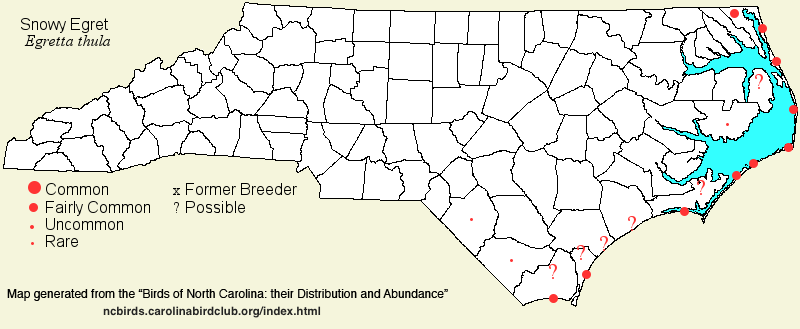 |  |
|
Snowy Egret - Egretta thula ARDEIDAE Members: | Search Common: Search Scientific: |
|
|
|||||||
| General Comments | The elegant Snowy Egret has, sadly, shown an alarming decline in numbers along the East Coast since the 1990's, for reasons that are not clear, as many other waders are not in a decline. Perhaps this and several other smaller species are not able to handle intense predation pressure from Fish Crows, Raccoons, and other species at nesting colonies; or perhaps coastal storms have impacted nesting colonies of the species. Water quality or amount of habitat does not seem to be enough of a concern to contribute to the more than 70% decline in nesting numbers in the state since about 1990. This species is still seen in small to moderate numbers on most coastal birding outings, and birds feed in shallow waters of fresh and brackish ponds, pools, and shorelines, and on mudflats. As with the Great Egret, they also occur along salt water channels and tidal mudflats; thus, habitat is hardly a limiting factor in its decline. The species breeds almost exclusively on coastal islands, but there are at least two inland nesting sites. | ||||||
| Breeding Status | Breeder | ||||||
| NC BRC List | Definitive | ||||||
| State Status | SC | ||||||
| U.S. Status | |||||||
| State Rank | S2S3B,S3N | ||||||
| Global Rank | G5 | ||||||
| Coastal Plain | Permanent resident along the coast, being migratory and thus more numerous in spring, late summer, and fall. Fairly common to locally common (but declining) along the entire coast, from Mar through Oct; in winter, less numerous -- mostly fairly common along the southern coast and uncommon to fairly common along the northern coast. Breeds at scattered colonies on small islands along the coast, plus currently at Lay's Lake (Columbus) and Dunahoe Bay (Robeson); formerly nested at a few other inland sites. In Tidewater, uncommon to locally fairly common (such as at Lake Mattamuskeet) in the warmer months, but rare in winter; not known to breed in this area. Farther inland, a rare to uncommon post-breeding visitor, mainly Jul to Sep; rare in spring (Apr and May); very rare at other times -- Jun, and Oct to Mar. Peak counts: | ||||||
| Piedmont | Transient, but primarily a post-breeding visitor. Rare to uncommon in the eastern portion (mainly at Falls and Jordan lakes), and rare (currently) to very uncommon over most of the remainder of the province, during July to Sep. Rare spring migrant in the eastern portions (mainly Apr and May), but very rare westward. Apparently no records from mid-Oct to the end of Mar. Peak counts: 7, Lake Wheeler (Wake), 22 Apr 1984. | ||||||
| Mountains | Transient and post-breeding visitor. Very rare in the lower elevations (generally below 2,500 feet), early Apr to late May, and early Jul to mid-Sep, rarely to 4 October. Most records are for Henderson. Peak counts: 7, Hooper Lane (Henderson), 1-9 Aug 2024; 4, Hooper Lane, 25-31 Jul 2024; 2, Lake Junaluska (Haywood), 12 Apr 2008. | ||||||
| Finding Tips |
Though clearly declining, you should have little trouble finding the species along the immediate coast at both tidal areas and freshwater impoundments, at least in the warmer months. **** | ||||||
| Attribution | LeGrand[2025-02-03], LeGrand[2024-11-04], Howard[2018-02-02] | ||||||
| NC Map Map depicts all counties with a report (transient or resident) for the species. | Click on county for list of all known species. |
| NC Breeding Season Map Map depicts assumed breeding season abundance for the species. |  |